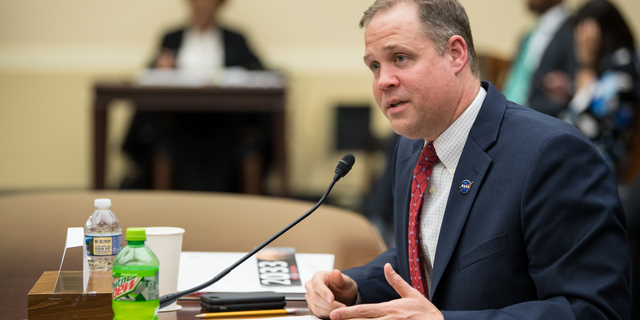NASA is developing its first planetary-defense mission to combat potential threats from rogue asteroids
NASA is developing its first planetary-defense mission called the Double Asteroid Redirection Test, or DART. DART will carefully study a near-Earth asteroid and then collide with it, giving scientists the data they need to develop a plan should they ever need to redirect a truly threatening asteroid.
NASA Administrator Jim Bridenstine is sounding the alarm that an asteroid strike is not something to be taken lightly and is perhaps Earth's biggest threat.
Speaking at the International Academy of Astronautics' 2019 Planetary Defense Conference in College Park, Md., on Monday, Bridenstine said the space agency and other asteroid scientists need to make sure people understand that the threat is very real and not just the imagination of big-budget blockbuster movie directors.
"We have to make sure that people understand that this is not about Hollywood, it's not about movies," Bridenstine said at the conference, according to Space.com. "This is about ultimately protecting the only planet we know right now to host life, and that is the planet Earth."
"We know for a fact that the dinosaurs did not have a space program. But we do, and we need to use it," Bridenstine added, attempting to portray planetary defense on the same level as a return trip to the Moon. The Trump administration wants to see astronauts return to the Moon by 2024, with or without the help of NASA.

NASA Administrator Jim Bridenstine testifies before the House Committee on Science, Space and Technology on April 2, 2019, during a hearing to review NASA’s fiscal year 2020 budget request.
Bridenstine knows the perils of asteroid strikes all too well. In February 2013, he had been a Congressman in Oklahoma for just a month when a devastating asteroid streaked across the Russian sky.
Known as the Chelyabinsk Event, it was the largest known meteor strike in over a century and it injured more than 1,600 people. It "released the energy equivalent of around 440,000 tons of TNT," according to NASA.
"I wish I could tell you these events are exceptionally unique," Bridenstine said during the presentation, noting they have occurred three times in the past 100 years. "But they are not."
Currently, there are two asteroid-centric missions going on around the world — NASA's OSIRIS-REx probe, which reached the Bennu asteroid in December 2018, and the Japanese Hayabusa2 spacecraft, which recently "bombed" the Ryugu asteroid in an effort to learn more about it.
Bridenstine highlighted the scientific importance of both of these missions but added that planetary defense is also an important component. "Yes, it's about science, it's about discovery, it's about exploration, but one of the reasons we do those missions is so that we can characterize those objects to protect, again, the only planet we know to host life."
"We have to use our systems, use our capabilities to ultimately get a lot more data, and we have to do it faster," Bridenstine said.
Planetary defense
When it comes to planetary defense, NASA is not sitting on its haunches, having taken several steps to protect Earth by detecting and tracking near-Earth Objects, also known as NEOs.
Last June, NASA unveiled a 20-page plan that details steps the U.S. should take to be better prepared for NEOs, asteroids and comets that come within 30 million miles of Earth. Lindley Johnson, the space agency's planetary defense officer, said at the time that the country "already has significant scientific, technical and operational capabilities" to help with NEOs, but implementing the new plan would "greatly increase our nation’s readiness and work with international partners to effectively respond should a new potential asteroid impact be detected.”
There are approximately 18,000 known NEOs and that number is constantly growing.
In 2016, NASA formalized the agency’s prior program for detecting and tracking NEOs and put it inside its Science Mission Directorate.
NASA will launch its first asteroid defense mission, the Double Asteroid Redirection Test (DART) mission, in 2022. Earlier this month, NASA awarded a $69 million contract to SpaceX, the space exploration company led by Elon Musk, to help with DART.
Currently, asteroid scientists from around the world are conducting a drill showing what the various global agencies would do about a potential asteroid collision. For the first time, the drill is being played out over social media. Updates of the hypothetical event are being shared on the ESA Operations Twitter account until May 3.
Source: Read Full Article
